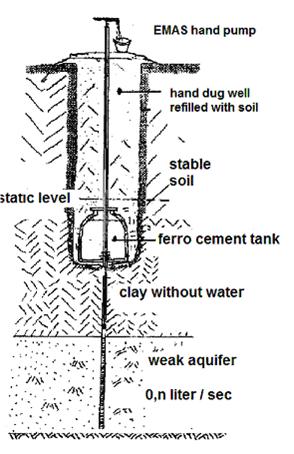Rooted Reservoir Well
| |
|
|
|
|
|
|
|
|
Refilled wells are commonly used in Asia and in other parts of the world. A well is excavated with temporary walls. A ferrocement tank is then placed in the bottom. A pipe and pump are installed, after which the well is refilled with soil. The advantage of this is that building them is very inexpensive, since the walls do not need to be coated. The water is also protected better against contamination. However when the water table drops during years of drought, no possibility exists to deepen them.
For this reason the EMAS rooted reservoir well is the ideal solution in areas with weak aquifers with limited water supply. Here a well is excavated with a reservoir tank above the water table, in solid soil. A pipe is drilled deeper into the weak aquifer. When the water level is high, water can be directly pumped. If the water is not pumped, it collects in the tank, to be used during dry spells.
EMAS is the acronym for Escuela Móvil de Agua y Saneamiento (Mobile School for Water and Sanitation), in Bolivia, whose director, Wolfgang Eloy Buchner, developed the EMAS pump in the 1990's. EMAS is not only the name of the mobile school for water and sanitation, but also a whole technical and social concept of water and sanitation which includes rain water harvesting, solar water heaters, windpower, hydraulic rams, water treatment, small tanks and sinks, a variety of hand and foot pumps, and ferrocement tanks. The aim of the technologies and systems is to achieve the necessary supply of drinkable water, and water for micro irrigation in rural and sub urban areas.
Suitable Conditions
The system is suitable for aquifers which are not always suitable for direct pumping, since the water supply is unreliable.
| Advantages | Disadvantages |
|---|---|
| - Much less costly than excavated wells - It has a higher yield than an excavated or refilled well |
Construction, operations and maintenance
You begin with the usual exploration drilling of the EMAS system. When testing, if you observe that the aquifer of the well is not sufficient for direct pumping, you should set up a ferro cement tank, to provide an extra water supply.
Excavate around the EMAS well down to a few meters below the phreatic level. When the excavation is finished, the pre manufactured ferro cement tank is brought down, above the well pipe. Some holes are made at the bottom of the tank for the pipe to pass through. When pumping, water will flow through this hole from the tank to the well, partially feeding the pump. At times when no pumping takes place, water at the well rises, filling the tank once more. Thus the tank compensates the higher demand of water when pumping. The size of the tank depends on the volume of the well drilled, and on the continuous demand. The usual size is 150 liters (regarding how to set up the ferro cement tank, please see the page Classical ferrocement tank).
Manuals, videos and links
- Well revival effort sees many other benefits A community drive to revive wells in Mokhla talab near Udaipur results in water security for longer periods of time as well as making leaders out of women.
- Experiments with 'community wells' Mobilized farmers in Dhule, Maharashtra, show how communities can use groundwater as a common resource in an organised and collective manner.


